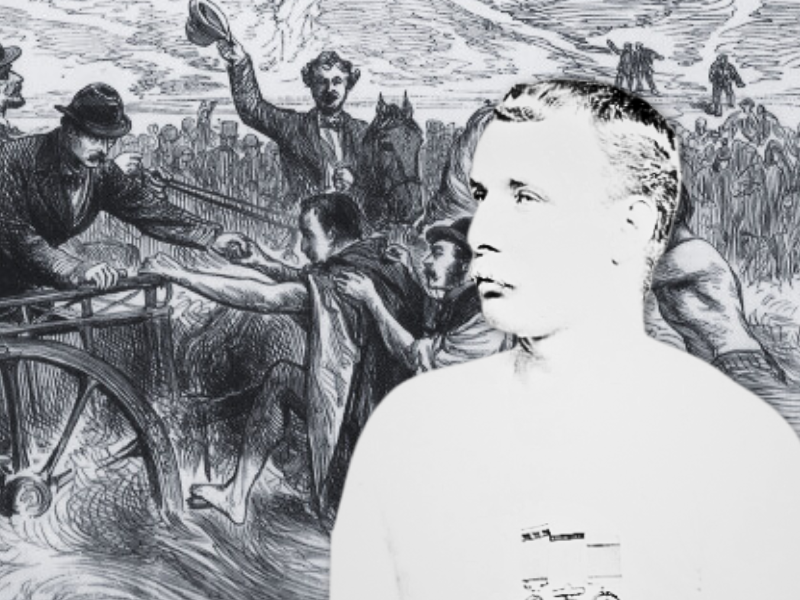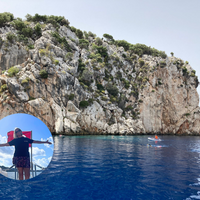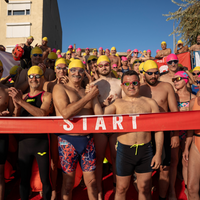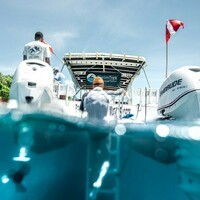'Nothing great is easy' - it's a phrase so familiar it's easy to forget who it is attributed to, or what it means exactly…
In 1909, Thomas Webb unveiled a memorial drinking fountain for his younger brother in Dawley. These words were inscribed in stone under a bronze bust, stained bluish-green by verdigris.
Who was the man who inspired this inscription? And what was his legacy?
Well, his name - Captain Matthew Webb - will be familiar to many of you who know him as the first swimmer to cross the English Channel, without any aids - a feat he accomplished on the morning of 25 August 1875, after 22 hours in the water.
 Webb arrives at Calais (From The Illustrated London News)
Webb arrives at Calais (From The Illustrated London News)
The more you read about Captain Webb the clearer it becomes that he was a man of complexity, hounded and valorised for the English Channel swim that made him famous.
In a few days (on August 25th) we will celebrate the 150th anniversary of Captain Webb's Channel crossing. Far and wide, swimmers will be marking the occasion by diving headlong into their local seas. So, we thought this would be perfect opportunity to celebrate the moustachioed icon who was first to forgo the need of a ship to cross from England to France.
Figures like Webb helped popularise endurance swimming and are partly responsible for inspiring the multitude of swimmers we see taking part in our events every year - like our Caribbean crossing from Nevis To St Kitts and the annual Bosphorus River Swim at the heart of Istanbul.
We owe a special debt of gratitude to those inspiring individuals, like Webb, who left such influential wakes and helped create the seaborne sport we all love.
The Boy
Webb was born in industrial Dawley, a former mining town, in January 1848. Despite being the second son of a doctor, he came from humble origins - a Shropshire lad who would grow up to one day become the toast of the British Empire.
In 1856, the Webb family moved to Coalbrookdale and lived near the River Severn. This is where Webb began to form his earliest memories of the water. After school he and his friends would escape to play in the Severn, ride its currents and splash in the riffles. By the age of 7, Webb could already swim. The following year, he and his brother, Thomas, even saved their younger brother Charles from drowning. Then, four years later, Webb left school and joined the merchant service, applying to be either first or second mate.
In his youth, Webb had often told grand sea stories as he showed off to his friends. Some sources say he was inspired to become a seaman by the Victorian adventure book ‘Old Jack’, written by William Kingston.
“I had made up my mind to go to sea — why, it’s hard to say, except that I thought I should like to knock about the world and see strange countries…” - William Kingston (Old Jack)
 Photograph of Matthew Webb (From Openwaterpedia)
Photograph of Matthew Webb (From Openwaterpedia)
The Mariner
At the start of his service, Webb was based on the SS Conway, until 1862, as well as serving as an apprentice on other boats. During his three-year apprenticeship, he fulfilled his dream to be like 'Old Jack' and sailed the world trade routes to far-flung countries, including, India, Singapore, and Yemen.
For 10 years, since 1865, Webb moved between different ships, making a name for himself with two incredible acts of bravery. The first occurred in the Suez Canal when Webb freed his ship’s propeller from an entangled rope, diving underwater to cut it loose. The second is the more famous of the two stories, which involved Webb leaping into the stormy clutches of the mid-Atlantic. A crewmate had been swept overboard in a gale and Webb went in to save him with no hesitation.
After 37 minutes in that frothy cauldron of cold, salty water - Webb almost drowned and sadly failed to recover the sailor, who swiftly disappeared. In the aftermath, Webb was brought to the notice of the public for his daring rescue attempt and awarded the Stanhope Gold Medal by the Royal Humane Society.
 Actor Warren Brown as Captain Webb in 'The Greatest Englishman' (From Openwaterpedia)
Actor Warren Brown as Captain Webb in 'The Greatest Englishman' (From Openwaterpedia)
The Swimmer
If you think about it, it makes sense that Webb became a merchant mariner, considering the early influences on him as a boy. From a young age, he had proven his confidence in and around water. Then, during his service, he revealed his ability to survive the most punishing conditions at sea. Being spun, tossed and submerged at intervals by the Atlantic is an ordeal few could survive for a few minutes - let alone half an hour, or more.
What came next for Webb was probably less easy to predict. This stocky and broad-chested force of nature was about to leave his maritime career to enter a sport few even knew existed. His early adulthood was spent riding the briny in ships. Now, he was inspired to broach its surface at water level, keeping his head up during hours of wave-splattered breaststroke.
In the early 1870s, Webb hatched the idea that would etch his name in swimming history. He was actually a ship master at the time - records show he was at least in charge of his crew from 1875 onwards. A year earlier, he made it known that he intended to swim the Channel. He began to train off the pebbled beaches of Dover, overlooked by those famous faces of gleaming chalk. Each outing involved several hours of battling the waves and gritting his teeth in the cold. On easier sessions, he traded the sea for the lanes at Lambeth Baths, where he could still swim freely if the weather turned against him.
Webb failed his first attempt to cross the Channel on August 12th in 1875. Then he returned 12 days later, freshly lathered in porpoise grease. He dove off Admiralty Pier again on August 24th and began the slow slog out from Dover's shallows in the early afternoon.
There was an artist on one of the escort boats and journalists too, who reported a stop at 2:45pm when Webb swigged a cup of 'good ale'. Just imagine Channel swimmers stopping for a mid-crossing ale these days. More ale was then imbibed at 6:30pm and the evening was brought in with 'beef tea'.
On Webb swam, his gut bubbling with swilled ale and tea, as he pushed into nightfall. Unable to see far ahead of his own pale fingers, Webb was surprised by a jellyfish and suffered a nasty sting. Then the tide turned and began to drag him slowly in a south-westerly direction. An hour before midnight, he was between eight or nine miles from Calais.
In the early morning, the dawn light shone over Cape Grisnez and he was within reach of his goal. Sadly, a flood tide set in at 5 and he spent the sunrise battling the current, which pulled him eastwards to Calais. Gusts of wind ruffled the sea and waves spat against Webb’s face. At one point, a boat rowed on his windward side to offer some shelter.
Finally, Webb reached the long-sought relief of dry land at 10:41am. He stumbled ashore in France and was bundled into a carriage and whisked to the Hotel de Paris.
For 30 years, no other swimmer was able to join Webb in the glory of his world-first achievement. He remained the world's only Channel swimmer, until 1911 when Yorkshire-born Thomas Burgess finally made it across and became the second man to swim it.
 'First To Swim The Channel' comic strip of Captain Webb (From Openwaterpedia)
'First To Swim The Channel' comic strip of Captain Webb (From Openwaterpedia)
The Showman
Pioneers and showmen were all the rage in Victorian Britain. Early on, there was top-hatted Isambard Brunel - a master of mechanical giants, who famously designed and built the transatlantic steamship. Later, the escapologist Harry Houdini would also scramble out of straitjackets while submerged underwater. Suffice it to say that Victorian society had great interest in near-mythical figures, who seemed larger than life, as well as those who performed macabre displays of bravery.
Donations raised for the Webb's Channel crossing had soared to £2,424 – a small fortunate by today’s standards. This meant he was able to launch his career as a professional swimmer. To keep the show afloat, Webb went on to swim 64 kilometres from Gravesend to Woolwich, along the Thames, in 1877. Two years later, he swam 119 kilometres over 6 days as part of a long-distance swimming race, which he won. Strangely, he also floated for 128.5 hours at Boston Horticultural Hall in 1882 - maybe, inspiring Annette Kellerman, who later swam with fish in tanks at Exhibition Aquarium in Australia.
In a short time, Webb evolved from seaman to swimmer before being thrust onto the world stage as a stuntman of sorts. Propelled by the fame from his Channel swim, he gave lectures and performed exhibitions until around 1882. Try as he did, nothing could ever top his crowning achievement of crossing the Channel. Yet he went on with increasingly more daring challenges, striving to earn a living and maintain public interest.
In 1883, Webb was aged 35 when he announced his intention to swim Niagara Gorge. That year, he had raced his last competitive swim, busting out 32 kilometres in Lambeth Baths against Willie Beckwith. Ultimately, Webb was forced to withdraw from the race, coughing up blood on the poolside. It was revealed that he was sick with tuberculosis - by now, he had lost about 19 kilos since the day he swam the Channel.
At his hospital bedside, Webb's brother - who had since become a doctor - pleaded with Matthew, urging him to give up his obsession with long-distance swimming. Friends also spoke to Matthew and tried to convince him to give up his pursuit of more daring feats. One spoke of how he seemed downcast and ‘broken-spirited’ - the once handsome sailor was visibly haggard, courting death for money and fame.
 Swim-ready Captain Webb (From Openwaterpedia)
Swim-ready Captain Webb (From Openwaterpedia)
The Daredevil
At 4.25pm on 24th July 1883, pursued by poor finances and recovering from tuberculosis, Webb jumped from a small boat into the Niagara Gorge. Within 10 minutes, he was caught in a current and dragged under whorls of foam as a whirlpool formed. His body was not recovered until four days later, after which he was buried in nearby Oakwood Cemetery. Four days later, Webb's death was officially reported by the Illustrated London News, who celebrated him as the ‘bravest and greatest of swimmers’.
It is difficult to imagine what compelled Webb to enter that maelstrom, exposed to the crushing Niagara Falls, with little knowledge of the whirlpool rapids and the power of all that rolling water, which quickly left him paralysed.
More recently, one of our modern-day endurance swimmers, Ross Edgely, circumnavigated the British Isles. He was inspired by a simple mantra, arguing that to complete a seemingly insurmountable task you have to be ‘naïve enough to start, stubborn enough to finish’. By all accounts, Webb was stubborn enough to achieve almost anything - it was just that his naivety in this endeavour was too extreme.
Now, we better understand the force of that Niagara water, rushing at speeds of over 100 kilometres per hour. While the currents below spin foam-scribbled eddies up to 48 kilometres per hour. Every second, over 3000 tonnes of water is disgorged over the precipice of the falls as well – that’s equivalent to almost 500 fully grown African elephants!
 Sarah Thomas after her 'Four Way' English Channel crossing
Sarah Thomas after her 'Four Way' English Channel crossing
The Pioneer
Today, Captain Webb is remembered as a pioneer who dared to attempt and achieve extraordinary feats, inspiring countless others. Yet his story is a tragic one and ultimately the man fell victim to a pursuit of greatness, which strayed into unnecessary sacrifice.
Due to Webb's great swimming ability, the English Channel is now regarded as the ‘Everest of swimming’ - the ultimate test for endurance swimmers, who have become faster over the years, proving to be increasingly more resilient as they follow the example Webb set.
In 2019, Sarah Thomas famously became the first person ever to complete a four-way crossing of the Channel in 54 hours and 10 minutes. A rare aquatic phenom, equally humble and unstoppable, Sarah has proven how far our best ocean swimmers have come since Webb's ale-fuelled crossing, 150 years ago.
Last year, we spoke to Sarah about her own gruelling experience in the English Channel - you can read our full interview here.












